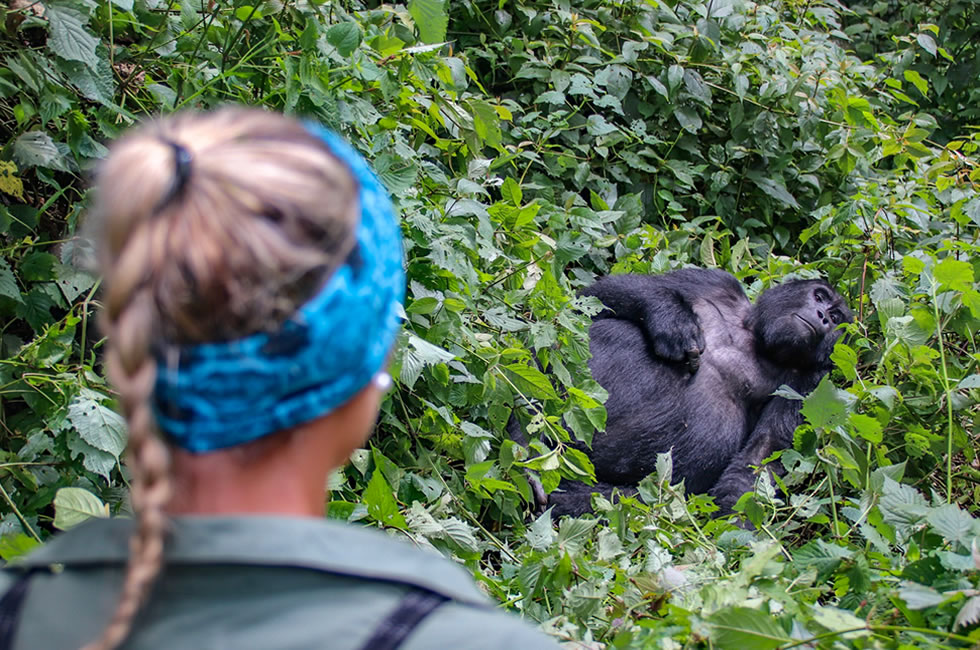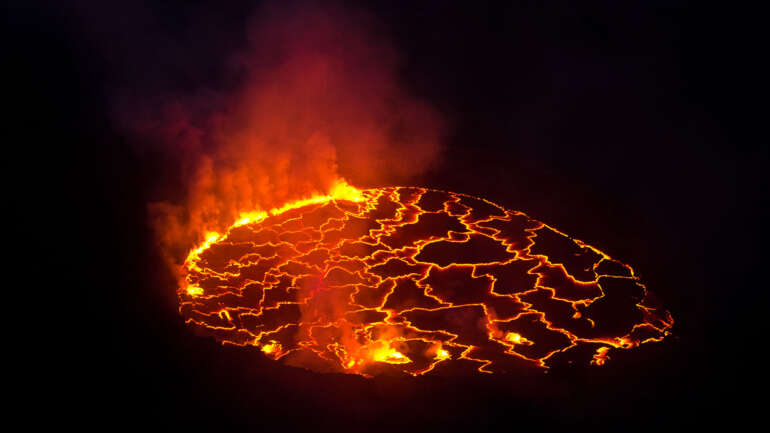Apparently mountain gorilla population is estimated to be 880 individuals living in the wild. These live in areas of the Virunga massif which span the borders of Rwanda, Uganda and DR Congo and in the Bwindi Impenetrable Forest National Park in southwestern Uganda which has half of their numbers about 400 mountain gorillas.
The growth of gorilla tourism in Uganda, Rwanda and DR Congo during the 1990’s was a secondary factor to conservation. Note, however, the official mountain gorilla tourism project started in 1979 but tourist visitations to gorillas in their natural habitat were not strictly controlled which therefore led to change and development of new practices that would guide gorilla tourism development.
Gorilla tourism was initiated to generate economic revenues that would help to fund conservation of gorillas and their habitats as well as the well being of local communities living around the gorilla national parks. Gorilla national parks include Bwindi Impenetrable Forest National Park and Mgahinga Gorilla National Park in Uganda, Volcanoes National Park in Rwanda and Virunga National Park in Democratic Republic of Congo.
The practices sought to be the best guidelines for gorilla tourism development were developed by expert scientists from the International Union for Conservation of Nature (IUCN) together with local and other international gorilla conservation bodies.
Such practices were based on the negative impacts that came out of uncontrolled gorilla tourism such as human borne disease transmission since some gorilla families were habituated and accustomed to humans, disturbance of gorillas due to regular visits, habitat loss and encroachment in addition to civil conflicts.
More negative impacts became apparent when gorilla trekking safaris became popular, hence there was need to control the number of gorilla trekkers, regulate infrastructure development such as hotels and park staff housing in and outside gorilla national parks. There was also the concern to monitor and evaluate the health of domestic animals living on the boundaries of gorilla parks.
The following are the practices which act as the best guidelines for gorilla tourism development in all the gorilla range states of Uganda, Rwanda and DR Congo.
- Regular monitoring of gorilla health through collection of gorilla excretions such as urine and dung for analysis to detect viruses. Research by scientists from the Mountain Gorilla Veterinary Project (Gorilla Doctors) confirmed that human diseases can pass to gorillas and lead to their death. This is based on the genetic fact that gorillas share more or less 98% of their DNA with humans hence very vulnerable to human infectious diseases such as colds, diarrhea, pneumonia which affect their respiratory system causing death.
- Gorilla tourism also helps to generate funds that manage gorilla national parks helping the apes to survive but has much increased tourist contact with gorillas through daily gorilla trekking.
Control of Visitor Numbers & Carrying Capacity
Regulating of tourist numbers on the gorilla trekking experience. This has been done through control of permits issued for gorilla treks in the different national parks. In order to prevent disturbance of gorillas as and other wildlife that live in the park, in Rwanda and Uganda allow only 8 tourists are allowed here as in DR Congo only 6 tourists can visit one habituated gorilla family for 1 hour per day.
This reduces stress on gorillas allowing them to act naturally. To enforce this, other gorilla trekking rules and regulations help to minimize tourist contact with gorillas. For instance, tourists must keep a minimum distance of 7 meters away while watching and photographing the gorillas in the forest.
Besides limiting tourist numbers during gorilla trekking experience, the gorilla trekking permits were intentionally made expensive so that few people can afford the cost of purchasing permits. This has also seen few gorilla trekkers who sacrifice and spend huge dollars in return for a quality trekking experience.
Control of Diseases
Additionally, gorillas live a midst high human populating densities high local people’s contact with gorillas. In 2008, habituated gorilla families in Volcanoes National Park Rwanda were identified with respiratory diseases experiencing colds and coughs. Also in 2012 in Bwindi impenetrable forest national park silverback gorilla was reported dead from a head wound. Therefore disease surveillance and multiple interventions by gorilla doctors to treat sick or injured gorillas have greatly helped to save gorillas from human diseases.
In DR Congo tourists wear surgical masks to limit spread of human diseases and this has been an authoritative tool for the long term gorilla tourism development and conservation.
The rules and regulations also restrict contamination of gorilla habitats by tourist while rangers and guides set good example. Eating and drinking is not allowed and all human waste must be buried 30 centimeters underneath so that gorillas are unable to be infected by human waste.
Protection of National Parks
Strict protection of mountain gorilla population and their natural habitats in the virunga conservation area and Bwindi-Mgahinga conservation area is another practice for gorilla tourism development. In the individual gorilla national parks there are permanent wildlife ranger forces that repeatedly carry out day and night extended patrols gathering data based on resources and gorillas.
This is called ranger based monitoring system where they use modern GPS to locate gorillas and illegal activities. Rangers are ever armed and backed by wildlife laws of the gorilla range states to kill or arrest and take to courts of law any of the suspected poachers or encroachers. This has ensures security of gorillas, their habitats and tourists as well.
Collaborative Management
In addition to the individual gorilla park rangers, the International gorilla conservation program facilitated the signing of Trans-boundary gorilla management memorandum of understanding between Rwanda, Uganda and DR Congo. Gorillas often cross borders which may expose them to poachers.
Keeping a large number of mountain gorillas un-habituated. There is a high risk associated with habituated gorilla families in case of human disease outbreaks they can be easily exterminated. Hence it’s very relevant to maintain a bigger population of gorillas un-habituated so that they are safe from the risk of diseases. In Uganda about 14 gorilla families have been exposed to tourism leaving 36 gorilla families un-habituated. In Rwanda only 10 gorilla families are habituated, 8 are not habituated while in DR Congo only 5 gorilla families are habituated.
Environmental Impact Assessment
Carrying out environmental impact assessment for any infrastructural program in and around the gorilla national parks. Tourism infrastructure such as hotels, lodges, campsites including park staff housing facilities must be built with eco friendly colors/materials so that they do not scare wildlife or damage the ecosystem.
Infrastructures also generate a lot of waste ranging from metals, water, glasses, paper to non biodegradable plastics and polythene papers. Hence each and every hotel, lodge or camp must have mechanisms to manage such waste such as recycling. The use of solar and bio gas energy is recommended to reduce emission of green house gases such as carbon and methane which contribute to global warming and climate change.
However, infrastructure development such as roads, banks, electricity, hotels has not only improved service delivery in national parks but have also benefited the local communities by providing easy access to market for food staffs such as vegetables, fruits, grains and matoke.
Continuous sensitization of communities living around the gorilla national parks is essential. Community conservation and education is one of the departments whose key role is to educate the people about the importance of gorillas and other wildlife. Links have between livelihoods of people and wildlife have been created for instance there are multiple use zones where locals can sustainably extract honey, medicinal plants, weaving, craft making and housing materials.
Also, through the community conservation departments in all gorilla national parks partners with gorilla conservation organizations in strengthening groups of people, diversifying income. For instance women groups around Bwindi have set up vegetable and fruit growing projects, cultural villages and craft shops around volcanoes national park such as Iby’iwacu cultural village, camps and lodges. Hence tourists who visit gorillas also visit the communities.
Gorilla tourism development is therefore a win-win situation; if conservation of gorillas and gorilla tourism does not contribute to well being of people they become irrelevant. Those practices are very significant for both conservation, development of gorilla tourism and well being of local communities.

